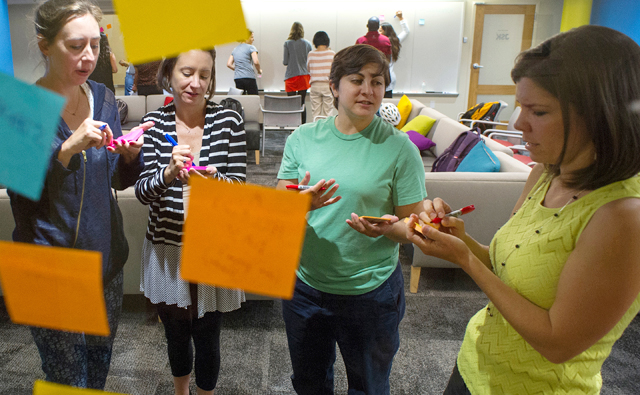
Increasing the impact of the Knight Fellowships program at Stanford
2015 John S. Knight Journalism Fellows Christina Passariello (left), Anne Kornblut, Zena Barakat and Charla Bear take on the challenges of journalism during a brainstorming session last month. Photo: Samaruddin Stewart
Jim Bettinger is director of the John S. Knight Journalism Fellowships at Stanford. The program fosters journalistic innovation, entrepreneurship and leadership; each year it brings 20 journalists and journalism entrepreneurs from the U.S. and around the world to spend the year at Stanford. It was founded in 1966 as the Stanford Professional Journalism Fellowships program and was renamed for Knight Foundation co-founder John S. Knight in 1984, after the foundation made a major gift to endow the program.Related Link
“John S. Knight Journalism Fellowships at Stanford University to further advance innovation through new program initiatives” – Press release (10/07/2014)
We believe in journalism. We believe in journalism so much that we’re constantly looking for new ways that our fellows and our program can make journalism better — in the future and right now.
And that’s why we’re so amped about our new initiatives, which $1.8 million in new support from Knight Foundation will enable us to pursue. This will:
· Give us resources to increase our fellows’ impact, especially after their year at Stanford.
· Help us create a technology resource curriculum that will be useful not just to our fellows but to journalists everywhere.
· Enable us to convene — at Stanford University — small groups of top editors and news leaders for grounding in the latest thinking about innovation, human-centered design and leading organizational change.
Journalism fellowships at Stanford began nearly 50 years ago with a cool idea: If you give reporters and editors free rein at a great university, the payoff will be superb journalism. That worked for a long time. But when we recognized that the challenges to journalism — and the possibilities — were greater than anyone could have imagined, we knew the original idea wasn’t enough.
So for the past five years our program has focused on journalism innovation, entrepreneurship and leadership. (If you are curious what we mean by these terms, take a look here. Just don’t assume that we’re a technology fellowship, or a product fellowship, or a digital fellowship. We’re not. We’re a JOURNALISM fellowship.)
We ask our fellows to come with a great idea — a journalism challenge of their devising that they will work on during the year. Ideally their work leads to something that will help journalism and journalists. They draw on the resources of Stanford, whether it’s emerging technologies, such as virtual reality, or innovative approaches, such as the “design thinking” championed at the university’s d. school, in reaching their goals.
We’re pretty open-minded about the forms this can take. Sometimes it’s fostering new collaborations, such as Migrahack, which uses hackathons to help Spanish-language media transform the confusing morass of immigration data into stories and visualizations.
Sometimes fellows use existing technology to create new tools, such as the Investigative Dashboard, a suite of tools for cross-border investigative reporting, or the Knight Foundation-supported FOIA Machine, an open-source platform for preparing, filing and tracking multiple Freedom of Information Act requests.
(By the way, Migrahack and FOIA Machine found post-fellowship homes in the Institute for Justice & Journalism and the Center for Investigative Reporting/Investigative Reporters and Editors respectively. Investigative Dashboard has received support from Google Ideas and Open Society Institute.)
Other times, the impact comes from the ripple effect that our fellows have in existing news organizations, such as the Alabama Media Group, where Michelle Holmes is vice president of content. She’s been cited by the American Press Institute for creating a culture around engagement and reporting in the short time she’s been there.
Our fellows share a bias for action. Last winter several of them were trying to make sense of the torrent of social media flowing out of Venezuela as civil unrest grew. They were frustrated, so they did something. In a matter of weeks, they built a solution to their problem: Venezuela Decoded, which has received international attention.
So our fellows are already having impact — and Knight Foundation’s support will enable us to increase that impact, by providing them resources after their fellowship year. We can’t wait!
A key element of our ethos has been a focus on the future of journalism — especially to distinguish us from those who couldn’t get beyond bemoaning what journalism has lost. We took our cue from computer guru Alan Kay, who famously said, “The best way to predict the future is to invent it.” We’re not giving that up.
But we’re also renewing our commitment to journalism’s present. Among our fellows this year are several who are working on challenges of direct relevance to their news organizations and are staying in regular contact. In the past we would have frowned on this, because we wanted them to distance themselves from their news organizations and immerse themselves in their Stanford studies.
But you know what? It’s 2014.
Recent Content
-
Journalismarticle ·
-
Journalismarticle ·
-
Journalismarticle ·


